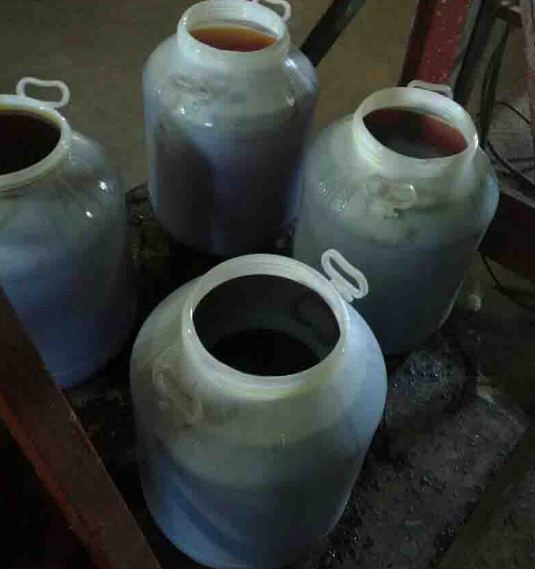Primary Emulsifier | Secondary emulsifiers CAS 68476-34-6
Primary and secondary emulsifiers
All Zhejiang Camp-Shinning’s CPMUL-P has been put through very strict testing. The results of these thorough tests show that CPMUL-P does a great job of keeping a high electrical stability (ES), low amounts of HTHP filtrate, and the right rheological qualities at working temperatures of up to 149°C (300°F).
CPMUL-S from Zhejiang Camp-Shinning works as a secondary lubricant in oil-based mud systems. CPMUL-S does a great job of emulsifying, helps make the reverse emulsion more stable at high temperatures, and gives you more control over high-temperature, high-pressure (HTHP) filtration.
Zhejiang Camp-Shinning have put CPMUL-S through a lot of testing. We take into account base oils, mud densities, oil-to-water ratios, and hot-rolling temperatures. These thorough tests show that when CPMUL-P and CPMUL-S are used together, they keep high electrical stability (ES), low HTHP filtrate levels, and the desired rheological qualities at working temperatures of up to 149°C (300°F).
Difference between primary and secondary emulsifiers
Emulsifications are made easier by lowering the amount of energy needed to make an emulsion by using primary emulsifiers. A solid emulsion with drops of water spread throughout the oil phase is created.
The secondary emulsifier is used to make emulsions of oil in water. The oil phase is spread out in the constant water phase of these emulsions. The secondary emulsifier works with the primary emulsifier to further stabilize the emulsion system, increase the efficiency of emulsification, and make the oil-in-water emulsion more stable overall.
Different things that help make an emulsion: Water-in-oil emulsions are what primary emulsifiers are made to break up. They are made up of molecules that are designed to lessen the strain between water and oil. Secondary emulsifiers can be used for more things. Water-in-oil emulsions are used in many different businesses, such as making makeup, drugs, and food. The primary types of emulsifiers used in these situations give the end goods structure, smoothness, and controlled release.
Primary Emulsifier
When the interfacial tension between liquids is lowered, a stable emulsion may be formed. This is the job of the primary emulsifier. The formulation of this emulsifier is focused on achieving effective emulsification and long-term stability, and the emulsifying qualities it has reflect this. The primary emulsifier prevents phase separation and maintains emulsion homogeneity by forming a protective barrier at the interface between the immiscible liquids.
Description
When working with oil-based mud systems, Zhejiang Camp-Shinning’s CPMUL-P is an excellent main emulsifier. This emulsifier is created from a low-toxic organic solvent, oxidized fatty acids, and modified amidoamine. High electrical stability, low amounts of high-temperature, high-pressure filtrate. These are appropriate rheological qualities of the emulsion are all things that CPMUL-P is designed to preserve.
This substance has a special makeup that allows it to lower the tension between oil and water, making it easier to mix them together. CPMUL-P helps to maintain the stability and balance of emulsions, even when faced with difficult conditions. The use of this emulsifier in oil-based mud systems results in stable, high-performance emulsions. You may have faith in its efficacy since it has been thoroughly studied and tried.
Specification
The CPMUL-P from Zhejiang Camp-Shinning is a really good primary emulsifier that works great in oil-based mud systems. This emulsifier is created from a low-toxic organic solvent, oxidized fatty acids, and modified amidoamine. High electrical stability (ES), low amounts of high-temperature, high-pressure (HTHP) filtrate, and the appropriate rheological qualities of the emulsion are all things that CPMUL-P is designed to preserve.
This substance’s unique composition reduces the surface tension between oil and water, facilitating their combination. CPMUL-P aids in keeping emulsions stable and in equilibrium, even under adverse circumstances. The use of this emulsifier in oil-based mud systems results in stable, high-performance emulsions. You may have faith in its efficacy since it has been thoroughly studied and tested.
Application
Start by adding 25 grams of anhydrous CaCl2 to 75 milliliters of distilled water and mix until dissolved. Make sure to mix the solution well and store it properly for future use. Making the emulsion with CPMUL-P and CPMUL-S.
Begin by adding White oil 5# to the mixing cup of a Hamilton Beach Mixer. Start by setting the mixer to low rpm. Then, slowly add the necessary amount of CPMUL-P and CPMUL-S into the oil while ensuring they dissolve completely. After it has dissolved, increase the stirring speed to 11000rpm.
While stirring at a higher speed, gradually pour in the 25% CaCl2 solution that you have prepared into the oil. Next, add the remaining additives in the order specified, starting with lime, followed by CP-150, rev dust, and finally barite. Once you’ve added all the additives, keep stirring at a speed of 11000rpm for 30 minutes to make sure everything is mixed well and the emulsion is formed.
Advantages
CPMUL-P from Zhejiang Camp-Shinning is designed to make it easier to mix water and oil phases in oil-based mud systems by providing excellent emulsification properties.
Because of this, the invert emulsion may be employed in situations when temperatures are quite high. This demonstrates that it is stable up to 149 degrees Celsius (300 degrees Fahrenheit), where its performance is still optimal.
It helps with filtration management in extreme conditions like high heat and pressure. It aids in lowering the high-pressure, high-temperature filtrate, which is essential for achieving the necessary level of filtration control in an oil-based mud system.
We, as a China primary emulsifier manufacturer, have tested CPMUL-P thoroughly in different oil-based mud mixtures, taking into account factors like the type of base oils used, mud densities, oil to water ratios, and hot-rolling temperatures. This makes sure that it works well and is appropriate for various situations, giving consistent results in different uses.
It is commonly used as the primary emulsifier in oil-based mud systems. It can be used in industries like oil and gas, where stable emulsions are necessary for drilling and mud performance.
Package
Zhejiang Camp-Shinning is one of the top-notch China primary emulsifier factories. The main emulsifier for oil-based mud, CPMUL-P, comes in drums that are easy to handle and transport. Packaging drums typically come in a standard size of 180 kilograms, which is equivalent to 55 gallons. You can call us to customize the options of your packaging.
A 20-foot container can hold around 14.4 metric tons (MT) of CPMUL-P drums on pallets for shipping. This makes sure that space is used efficiently when transporting things. Zhejiang Camp-Shinning strives to deliver orders promptly as per the timeline. Expect to receive your product within 7 to 10 days after we receive your deposit.
Zhejiang Camp-Shinning’s CPMUL-P primary emulsifier for oil-based mud is packaged in drums that are designed to be convenient, easy to handle, and efficiently utilized. The drums are also of a specified size to ensure timely delivery.
Emulsifying Agents | Primary Emulsifier
These are substances that help mix and stabilize liquids that normally wouldn’t mix together. These mixtures are called emulsions. Emulsifying agents are helpful in dispersing organoclay particles evenly throughout the liquid phase when used together. This makes it easier to create stable emulsions. These agents help the liquids that don’t normally mix to blend together smoothly by reducing the tension between them at their interface.
Wetting Agents
Also called surfactants or surface-active agents, are substances that improve the ability of liquids to spread and wet solid surfaces. Wetting agents help to spread and attach organoclay particles onto solid surfaces when they are used together. This helps to ensure that the organoclay and substrate interact well, resulting in better compatibility and performance.
Dispersants
Substances that aid in spreading solid particles, like organoclays, evenly throughout a liquid. Dispersants help to break down clumps and evenly distribute organoclay particles in the liquid when used with organoclays.
This leads to better stability and even distribution of the organoclay throughout the system. Dispersants are useful in preventing particles from settling, clumping together, and forming sediment. This helps to maintain the reliable performance of organoclays in a range of applications.Primary Emulsifier and organophilic clay are used for oil drilling mud.


